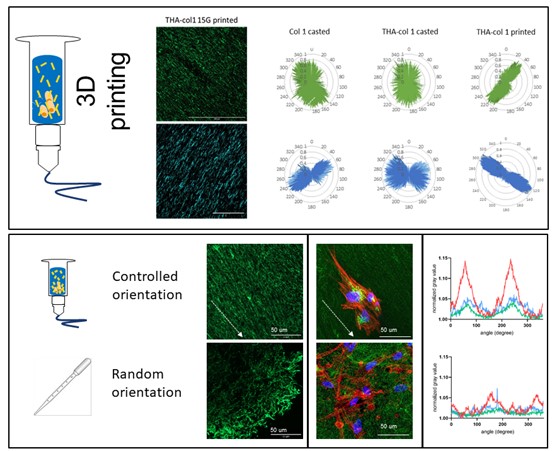Background
Osteochondral defects are still a major clinical challenge. They represent a large societal burden as they limit employment and impede daily life activities of millions of Europeans. Moreover, these injuries often lead to further degeneration of the joint, into a disabling disease known as osteoarthritis (OA). The defect bridges two major tissue types (cartilage and bone) that also have zonal structures within and specific healing capacities. Additionally, the cartilaginous surface must follow the patient specific contour of the surrounding tissue to avoid arthritic changes. In this project we bring together expertise in biomaterials and bioprinting to develop an additive manufacturing approach to produce constructs with precisely controlled internal architecture and the potential for patient specific implants. We are systematically investigating how to create collagen fibrils with controlled orientation within a hyaluronic acid-based matrix, thereby imitating the natural tissue composition. The possibility of printing matrix components with control over microscopic alignment brings biofabrication one step closer to capturing the complexity in animal tissues, opening new possibilities for clinical translation.
-
Publication
Schwab A, Levato R, D’Este M, Piluso S, Eglin D, Malda J (2020) Printability and shape fidelity of bioinks in 3D bioprinting. Chemical Reviews 120 (19), 11028-11055.
Schwab A, Hélary C, Richards RG, Alini M, Eglin D, D'Este M (2020) Tissue mimetic hyaluronan bioink containing collagen fibers with controlled orientation modulating cell migration and alignment. Materials Today Bio, 100058.
Schwab A, Alini M, Eglin D, D’Este M. 3D Drucken von Kollagenfibrillen mit Kontrolle über deren Orientierung in einer Hyaluronsäure Matrix als biomimetisches Knorpelimplantat. Zeitschrift für Orthopädie und Unfallchirurgie 158 (S 01), DKOU20-1036. DKOU 2020 (abstract)./p> Schwab A, Staubli F, Alini M, Eglin D, D’Este M. Einfluss der anisotropen Faserausrichtung und des Kollagen Typs und auf das chondrogene Differenzierungsverhalten. Zeitschrift für Orthopädie und Unfallchirurgie 158 (S 01). DKOU 2020 (abstract).
Zheng Z, Eglin D, Alini M, Richards RG, Qin L, Lai Y. Visible light-induced 3D bioprinting technologies and corresponding bioink materials for tissue engineering: A review. Engineering. 2020;epub Sep 20.
Zhou L, van Osch GJVM, Malda J, Stoddart MJ, Lai Y, Richards RG, Ki-Wai Ho K, Qin L. Innovative Tissue-Engineered Strategies for Osteochondral Defect Repair and Regeneration: Current Progress and Challenges. Adv Healthc Mater. 2020;epub Oct 26:e2001008.
Xu Y, Yin H, Chu J, Eglin D, Serra T, Docheva D. An anisotropic nanocomposite hydrogel guides aligned orientation and enhances tenogenesis of human tendon stem/progenitor cells. Biomater Sci. 2021;epub Feb 12 https://doi.org/10.1039/D0BM01127DFleischhacker E, Sprecher CM, Milz S, Saller MM, Gleich J, Siebenbürger G, Helfen T, Böcker W, Ockert B. Functional outcomes before and after implant removal in patients with posttraumatic shoulder stiffness and healed proximal humerus fractures: does implant material (PEEK vs. titanium) have an impact? - a pilot study. BMC Musculoskelet Disord. 2022;23(1):95. https://doi.org/10.1186/s12891-022-05061-x
Schwab A, Wesdorp TM, Xu J, Abinzano F, Levato R, Loebel C, Narcisi R, Burdick J, Malda J, Eglin D, Stoddart MJ, D'Este M, van Osch GJVM. Effect of biomaterial composition on cell migration and tissue formation for cell-free osteochondral defect repair. 2022 NBTE (oral)
-
Presentation
Schwab A, Eglin D, Alini M, D'Este M.Control of microarchitecture within biomaterial ink through 3D printing to guide cell migration. WBC 2020.
Schwab A, Eglin D, Helary C, Alini M, D'Este M. Chondrogenic hyaluronan bio-ink containing collagen fibers with controlled orientation modulating cell orientation and morphology. 2021 BIOFAB online (oral)
Eglin D, Sprecher C, Marquette C, Courtial EJ. Toward core-shell 3D printed photonic strain sensing medical device. 2021 ES Biomat virtual (poster)
D'Este M, Schwab A, Eglin DO, Staubli F. Micro-extrusion induced orientation of collagen fibrils embedded in hyaluronan and bioinks chondrogenic property. 2021 ES Biomat virtual (oral)
Schwab A, Staubli F, Eglin D, D'Este M. 3D Bioprinting of a tissue mimetic hyaluronan bioink containing collagen fibers with controlled orientation. 2021 EuroMat virtual (oral)
Staubli F, Stoddart M, D'Este M, Schwab A. Mesenchymal stromal cell spheroids – effect of cell packing and biomaterial composition on chondrogenic differentiation in vitro. 2021 EORS (oral)
Palladino S, Schwab A, Copes F, D'Este M, Candiani G, Mantovani D. Bioink from collagen and hyaluronic acid: design and characterization of a cardiovascular-specific formulation for 3D bioprinting. 2021 SSB+RM YSS (poster)
Schwab A, Staubli F, Alini M, D'Este M. Bioinks with controlled fiber architecture modulating cell behavior. 2022 ICRS (oral)
Schwab A, Staubli F, Stoddart MJ, D'Este M. Cell micro-pellets: An alternative to single cell embedding in biomaterials to evaluate the effect of material properties on chondrogenic differentiation. 2022 OARSI (hybrid / poster)
-
Partner
Burdick J, University of Pennsylvania
Mauck R, University of Pennsylvania
Levato R, University Medical Center Utrecht
Malda J, University Medical Center Utrecht
Ho K, Chinese University of Hong Kong
Qin L, Chinese University of Hong Kong
van Osch GJVM, University Medical Center Rotterdam
Stoddart M, AO Research Institute Davos


